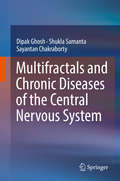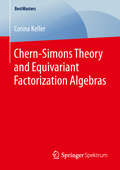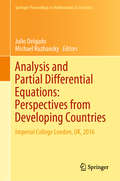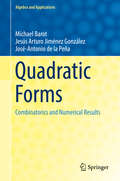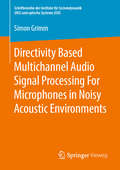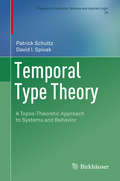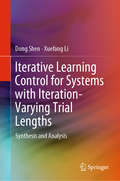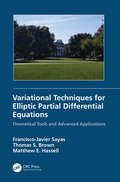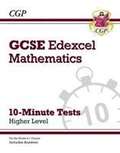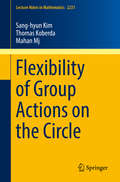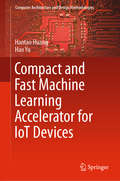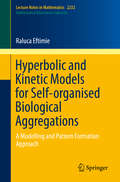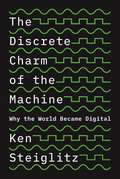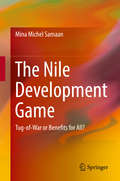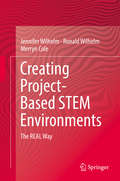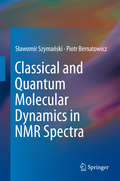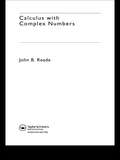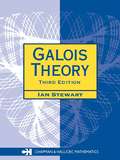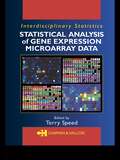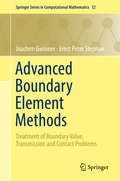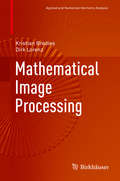- Table View
- List View
Multifractals and Chronic Diseases of the Central Nervous System
by Dipak Ghosh Shukla Samanta Sayantan ChakrabortyThis book primarily focuses on the study of various neurological disorders, including Parkinson’s (PD), Huntington (HD), Epilepsy, Alzheimer’s and Motor Neuron Diseases (MND) from a new perspective by analyzing the physiological signals associated with them using non-linear dynamics. The development of nonlinear methods has significantly helped to study complex nonlinear systems in detail by providing accurate and reliable information. The book provides a brief introduction to the central nervous system and its various disorders, their effects on health and quality of life, and their respective courses of treatment, followed by different bioelectrical signals like those detected by Electroencephalography (EEG), Electrocardiography (ECG), and Electromyography (EMG). In turn, the book discusses a range of nonlinear techniques, fractals, multifractals, and Higuchi’s Fractal Dimension (HFD), with mathematical examples and procedures. A review of studies conducted to date on neurological disorders like epilepsy, dementia, Parkinson’s, Huntington, Alzheimer’s, and Motor Neuron Diseases, which incorporate linear and nonlinear techniques, is also provided. The book subsequently presents new findings on neurological disorders of the central nervous system, namely Parkinson’s disease and Huntington’s disease, by analyzing their gait characteristics using a nonlinear fractal based technique: Multifractal Detrended Fluctuation Analysis (MFDFA). In closing, the book elaborates on several parameters that can be obtained from cross-correlation studies of ECG and blood pressure, and can be used as markers for neurological disorders.
Chern-Simons Theory and Equivariant Factorization Algebras (BestMasters)
by Corina KellerCorina Keller studies non-perturbative facets of abelian Chern-Simons theories. This is a refinement of the entirely perturbative approach to classical Chern-Simons theory via homotopy factorization algebras of observables that arise from the associated formal moduli problem describing deformations of flat principal bundles with connections over the spacetime manifold. The author shows that for theories with abelian group structure, this factorization algebra of classical observables comes naturally equipped with an action of the gauge group, which allows to encode non-perturbative effects in the classical observables.About the Author: Corina Keller currently is a doctoral student in the research group of Prof. Dr. Damien Calaque at the Université Montpellier, France. She is mostly interested in the mathematical study of field theories. Her master’s thesis was supervised by PD Dr. Alessandro Valentino and Prof. Dr. Alberto Cattaneo at Zurich University, Switzerland.
Analysis and Partial Differential Equations: Imperial College London, UK, 2016 (Springer Proceedings in Mathematics & Statistics #275)
by Julio Delgado Michael RuzhanskyThis volume presents current trends in analysis and partial differential equations from researchers in developing countries. The fruit of the project 'Analysis in Developing Countries', whose aim was to bring together researchers from around the world, the volume also includes some contributions from researchers from developed countries.Focusing on topics in analysis related to partial differential equations, this volume contains selected contributions from the activities of the project at Imperial College London, namely the conference on Analysis and Partial Differential Equations held in September 2016 and the subsequent Official Development Assistance Week held in November 2016. Topics represented include Fourier analysis, pseudo-differential operators, integral equations, as well as related topics from numerical analysis and bifurcation theory, and the countries represented range from Burkina Faso and Ghana to Armenia, Kyrgyzstan and Tajikistan, including contributions from Brazil, Colombia and Cuba, as well as India and China.Suitable for postgraduate students and beyond, this volume offers the reader a broader, global perspective of contemporary research in analysis.
Quadratic Forms: Combinatorics and Numerical Results (Algebra and Applications #25)
by Michael Barot Jesús Arturo Jiménez González José-Antonio de la PeñaThis monograph presents combinatorial and numerical issues on integral quadratic forms as originally obtained in the context of representation theory of algebras and derived categories. Some of these beautiful results remain practically unknown to students and scholars, and are scattered in papers written between 1970 and the present day. Besides the many classical results, the book also encompasses a few new results and generalizations. The material presented will appeal to a wide group of researchers (in representation theory of algebras, Lie theory, number theory and graph theory) and, due to its accessible nature and the many exercises provided, also to undergraduate and graduate students with a solid foundation in linear algebra and some familiarity on graph theory.
Directivity Based Multichannel Audio Signal Processing For Microphones in Noisy Acoustic Environments (Schriftenreihe der Institute für Systemdynamik (IDS) und optische Systeme (ISO))
by Simon GrimmSimon Grimm examines new multi-microphone signal processing strategies that aim to achieve noise reduction and dereverberation. Therefore, narrow-band signal enhancement approaches are combined with broad-band processing in terms of directivity based beamforming. Previously introduced formulations of the multichannel Wiener filter rely on the second order statistics of the speech and noise signals. The author analyses how additional knowledge about the location of a speaker as well as the microphone arrangement can be used to achieve further noise reduction and dereverberation.
Temporal Type Theory: A Topos-Theoretic Approach to Systems and Behavior (Progress in Computer Science and Applied Logic #29)
by Patrick Schultz David I. SpivakThis innovative monograph explores a new mathematical formalism in higher-order temporal logic for proving properties about the behavior of systems. Developed by the authors, the goal of this novel approach is to explain what occurs when multiple, distinct system components interact by using a category-theoretic description of behavior types based on sheaves. The authors demonstrate how to analyze the behaviors of elements in continuous and discrete dynamical systems so that each can be translated and compared to one another. Their temporal logic is also flexible enough that it can serve as a framework for other logics that work with similar models. The book begins with a discussion of behavior types, interval domains, and translation invariance, which serves as the groundwork for temporal type theory. From there, the authors lay out the logical preliminaries they need for their temporal modalities and explain the soundness of those logical semantics. These results are then applied to hybrid dynamical systems, differential equations, and labeled transition systems. A case study involving aircraft separation within the National Airspace System is provided to illustrate temporal type theory in action. Researchers in computer science, logic, and mathematics interested in topos-theoretic and category-theory-friendly approaches to system behavior will find this monograph to be an important resource. It can also serve as a supplemental text for a specialized graduate topics course.
Iterative Learning Control for Systems with Iteration-Varying Trial Lengths: Synthesis and Analysis
by Dong Shen Xuefang LiThis book presents a comprehensive and detailed study on iterative learning control (ILC) for systems with iteration-varying trial lengths. Instead of traditional ILC, which requires systems to repeat on a fixed time interval, this book focuses on a more practical case where the trial length might randomly vary from iteration to iteration. The iteration-varying trial lengths may be different from the desired trial length, which can cause redundancy or dropouts of control information in ILC, making ILC design a challenging problem. The book focuses on the synthesis and analysis of ILC for both linear and nonlinear systems with iteration-varying trial lengths, and proposes various novel techniques to deal with the precise tracking problem under non-repeatable trial lengths, such as moving window, switching system, and searching-based moving average operator. It not only discusses recent advances in ILC for systems with iteration-varying trial lengths, but also includes numerous intuitive figures to allow readers to develop an in-depth understanding of the intrinsic relationship between the incomplete information environment and the essential tracking performance. This book is intended for academic scholars and engineers who are interested in learning about control, data-driven control, networked control systems, and related fields. It is also a useful resource for graduate students in the above field.
Variational Techniques for Elliptic Partial Differential Equations: Theoretical Tools and Advanced Applications
by Francisco J. Sayas Thomas S. Brown Matthew E. HassellVariational Techniques for Elliptic Partial Differential Equations, intended for graduate students studying applied math, analysis, and/or numerical analysis, provides the necessary tools to understand the structure and solvability of elliptic partial differential equations. Beginning with the necessary definitions and theorems from distribution theory, the book gradually builds the functional analytic framework for studying elliptic PDE using variational formulations. Rather than introducing all of the prerequisites in the first chapters, it is the introduction of new problems which motivates the development of the associated analytical tools. In this way the student who is encountering this material for the first time will be aware of exactly what theory is needed, and for which problems. Features A detailed and rigorous development of the theory of Sobolev spaces on Lipschitz domains, including the trace operator and the normal component of vector fields An integration of functional analysis concepts involving Hilbert spaces and the problems which can be solved with these concepts, rather than separating the two Introduction to the analytical tools needed for physical problems of interest like time-harmonic waves, Stokes and Darcy flow, surface differential equations, Maxwell cavity problems, etc. A variety of problems which serve to reinforce and expand upon the material in each chapter, including applications in fluid and solid mechanics
New Grade 9-1 GCSE Maths Edexcel 10-Minute Tests - Higher (includes Answers) (PDF)
by Cgp BooksThis Edexcel GCSE Higher Maths book is packed with quick-fire tests, all at the perfect difficulty for students aiming for those high grades. It consists of over thirty bite-sized tests, containing a range of topics, calculator and non-calculator questions, plus those tricky problem solving questions. CGP’s 10-Minute Test books are absolutely perfect for short bursts of confidence-building exam-practice, so students are fully prepared on the big day. Answers and mark schemes are included, for easy marking and progress tracking.
Flexibility of Group Actions on the Circle (Lecture Notes in Mathematics #2231)
by Sang-Hyun Kim Thomas Koberda Mahan MjIn this partly expository work, a framework is developed for building exotic circle actions of certain classical groups. The authors give general combination theorems for indiscrete isometry groups of hyperbolic space which apply to Fuchsian and limit groups. An abundance of integer-valued subadditive defect-one quasimorphisms on these groups follow as a corollary. The main classes of groups considered are limit and Fuchsian groups. Limit groups are shown to admit large collections of faithful actions on the circle with disjoint rotation spectra. For Fuchsian groups, further flexibility results are proved and the existence of non-geometric actions of free and surface groups is established. An account is given of the extant notions of semi-conjugacy, showing they are equivalent. This book is suitable for experts interested in flexibility of representations, and for non-experts wanting an introduction to group representations into circle homeomorphism groups.
Compact and Fast Machine Learning Accelerator for IoT Devices (Computer Architecture and Design Methodologies)
by Hantao Huang Hao YuThis book presents the latest techniques for machine learning based data analytics on IoT edge devices. A comprehensive literature review on neural network compression and machine learning accelerator is presented from both algorithm level optimization and hardware architecture optimization. Coverage focuses on shallow and deep neural network with real applications on smart buildings. The authors also discuss hardware architecture design with coverage focusing on both CMOS based computing systems and the new emerging Resistive Random-Access Memory (RRAM) based systems. Detailed case studies such as indoor positioning, energy management and intrusion detection are also presented for smart buildings.
Hyperbolic and Kinetic Models for Self-organised Biological Aggregations: A Modelling and Pattern Formation Approach (Lecture Notes in Mathematics #2232)
by Raluca EftimieThis book focuses on the spatio-temporal patterns generated by two classes of mathematical models (of hyperbolic and kinetic types) that have been increasingly used in the past several years to describe various biological and ecological communities. Here we combine an overview of various modelling approaches for collective behaviours displayed by individuals/cells/bacteria that interact locally and non-locally, with analytical and numerical mathematical techniques that can be used to investigate the spatio-temporal patterns produced by said individuals/cells/bacteria. Richly illustrated, the book offers a valuable guide for researchers new to the field, and is also suitable as a textbook for senior undergraduate or graduate students in mathematics or related disciplines.
The Discrete Charm of the Machine: Why the World Became Digital
by Kenneth SteiglitzThe genesis of the digital idea and why it transformed civilizationA few short decades ago, we were informed by the smooth signals of analog television and radio; we communicated using our analog telephones; and we even computed with analog computers. Today our world is digital, built with zeros and ones. Why did this revolution occur? The Discrete Charm of the Machine explains, in an engaging and accessible manner, the varied physical and logical reasons behind this radical transformation.The spark of individual genius shines through this story of innovation: the stored program of Jacquard’s loom; Charles Babbage’s logical branching; Alan Turing’s brilliant abstraction of the discrete machine; Harry Nyquist’s foundation for digital signal processing; Claude Shannon’s breakthrough insights into the meaning of information and bandwidth; and Richard Feynman’s prescient proposals for nanotechnology and quantum computing. Ken Steiglitz follows the progression of these ideas in the building of our digital world, from the internet and artificial intelligence to the edge of the unknown. Are questions like the famous traveling salesman problem truly beyond the reach of ordinary digital computers? Can quantum computers transcend these barriers? Does a mysterious magical power reside in the analog mechanisms of the brain? Steiglitz concludes by confronting the moral and aesthetic questions raised by the development of artificial intelligence and autonomous robots.The Discrete Charm of the Machine examines why our information technology, the lifeblood of our civilization, became digital, and challenges us to think about where its future trajectory may lead.
The Discrete Charm of the Machine: Why the World Became Digital
by Kenneth SteiglitzThe genesis of the digital idea and why it transformed civilizationA few short decades ago, we were informed by the smooth signals of analog television and radio; we communicated using our analog telephones; and we even computed with analog computers. Today our world is digital, built with zeros and ones. Why did this revolution occur? The Discrete Charm of the Machine explains, in an engaging and accessible manner, the varied physical and logical reasons behind this radical transformation.The spark of individual genius shines through this story of innovation: the stored program of Jacquard’s loom; Charles Babbage’s logical branching; Alan Turing’s brilliant abstraction of the discrete machine; Harry Nyquist’s foundation for digital signal processing; Claude Shannon’s breakthrough insights into the meaning of information and bandwidth; and Richard Feynman’s prescient proposals for nanotechnology and quantum computing. Ken Steiglitz follows the progression of these ideas in the building of our digital world, from the internet and artificial intelligence to the edge of the unknown. Are questions like the famous traveling salesman problem truly beyond the reach of ordinary digital computers? Can quantum computers transcend these barriers? Does a mysterious magical power reside in the analog mechanisms of the brain? Steiglitz concludes by confronting the moral and aesthetic questions raised by the development of artificial intelligence and autonomous robots.The Discrete Charm of the Machine examines why our information technology, the lifeblood of our civilization, became digital, and challenges us to think about where its future trajectory may lead.
The Nile Development Game: Tug-of-War or Benefits for All?
by Mina Michel SamaanThis book introduces an analytic framework constructed upon the iterated Prisoners' Dilemma game to model and analyze transboundary water interactions along the Nile River. It presents a thorough and in-depth analysis of the historical path through which conflict and cooperation have been generated among the Nile riparians over large-scale developmental schemes. This is done through modeling water interactions in the basin as an iterated Prisoners' Dilemma game and employing process-tracing method to compare four distinguishable rounds of the game: the colonial round, the Cold War round, the post-Cold War round, and the post-2011 round. The book examines the influences of the changing political contexts at the domestic, regional, and global levels on the game outcomes. This framework is initially applied on several cases of international rivers worldwide, while the rest of the book is devoted to the Nile case. The book's central argument is that the riparians' interests, capabilities, and beliefs are heterogeneous in varying degrees and that the changing multilevel political contexts influence the level of such heterogeneities among the riparians, which ultimately drive the equilibrium dynamics in the Nile game to generate different conflictive and cooperative outcomes over time. Although the book's main conclusion indicates that the absence of economic interdependence and regional integration will transfer the game into tug-of-war, which will impose harsh punishment on the basin communities and ecosystems on the long term, the final chapter lists a group of recommendations addressed to the riparian states and international donors, exploring the way for boosting cooperation and preventing conflicts in the basin. Presenting clear theoretical, methodological, and policy implications, this book is appropriate for students and scholars of international relations, hydrology, and development studies.
Creating Project-Based STEM Environments: The REAL Way
by Jennifer Wilhelm Ronald Wilhelm Merryn ColeThis book models project-based environments that are intentionally designed around the United States Common Core State Standards (CCSS, 2010) for Mathematics, the Next Generation Science Standards (NGSS Lead States, 2013) for Science, and the National Educational Technology Standards (ISTE, 2008). The primary purpose of this book is to reveal how middle school STEM classrooms can be purposefully designed for 21st Century learners and provide evidence regarding how situated learning experiences will result in more advanced learning. This Project-Based Instruction (PBI) resource illustrates how to design and implement interdisciplinary project-based units based on the REAL (Realistic Explorations in Astronomical Learning – Unit 1) and CREATES (Chemical Reactions Engineered to Address Thermal Energy Situations – Unit 2). The content of the book details these two PBI units with authentic student work, explanations and research behind each lesson (including misconceptions students might hold regarding STEM content), pre/post research results of unit implementation with over 40 teachers and thousands of students. In addition to these two units, there are chapters describing how to design one’s own research-based PBI units incorporating teacher commentaries regarding strategies, obstacles overcome, and successes as they designed and implemented their PBI units for the first time after learning how to create PBI STEM Environments the “REAL” way.
Classical and Quantum Molecular Dynamics in NMR Spectra
by Piotr Bernatowicz Sławomir SzymańskiThe book provides a detailed account of how condensed-phase molecular dynamics are reflected in the line shapes of NMR spectra. The theories establishing connections between random, time-dependent molecular processes and lineshape effects are exposed in depth. Special emphasis is placed on the theoretical aspects, involving in particular intermolecular processes in solution, and molecular symmetry issues. The Liouville super-operator formalism is briefly introduced and used wherever it is beneficial for the transparency of presentation. The proposed formal descriptions of the discussed problems are sufficiently detailed to be implemented on a computer. Practical applications of the theory in solid- and liquid-phase studies are illustrated with appropriate experimental examples, exposing the potential of the lineshape method in elucidating molecular dynamics NMR-observable molecular phenomena where quantization of the spatial nuclear degrees of freedom is crucial are addressed in the last part of the book. As an introduction to this exciting research field, selected aspects of the quantum mechanics of isolated systems undergoing rotational tunnelling are reviewed, together with some basic information about quantum systems interacting with their condensed environment. The quantum theory of rate processes evidenced in the NMR lineshapes of molecular rotors is presented, and illustrated with appropriate experimental examples from both solid- and liquid-phase spectra. In this context, the everlasting problem of the quantum-to-classical transition is discussed at a quantitative level. The book will be suitable for graduate students and new and practising researchers using NMR techniques.
Dams in Brazil: Social and Demographical Impacts (SpringerBriefs in Latin American Studies)
by Guillaume LeturcqThe book focuses on the human and social effects of the construction of hydroelectric dams in Brazil. It discusses themes such as forced migrations, how the families of the victims of the dams adapt to new living areas, the struggle of families with the relocation of their homes and the fact that they are neglected by builders and government. These discussions are carried out in a comparative perspective between Southern and Northern Brazil, where contexts and living conditions are quite different. The book's main objective is to analyze the movements, adaptations and life changes in families suffering from the effects of dams throughout Brazil. This is the first book that analyzes the relationship dam-space with the intent to understand how dams affect the territory. The book is organized in three chapters: the dams’ effects in Brazil and the territorial impacts; human and social consequences of dam construction; a regional comparison of the effects of dams between the South and the North of the country.
Calculus with Complex Numbers
by John B. ReadeThis practical treatment explains the applications complex calculus without requiring the rigor of a real analysis background. The author explores algebraic and geometric aspects of complex numbers, differentiation, contour integration, finite and infinite real integrals, summation of series, and the fundamental theorem of algebra. The Residue Theo
Galois Theory
by Ian StewartGalois theory is a fascinating mixture of classical and modern mathematics, and in fact provided much of the seed from which abstract algebra has grown. It is a showpiece of mathematical unification and of "technology transfer" to a range of modern applications.Galois Theory, Second Edition is a revision of a well-established and popular te
Galois Theory
by Ian StewartGalois theory is a fascinating mixture of classical and modern mathematics, and in fact provided much of the seed from which abstract algebra has grown. It is a showpiece of mathematical unification and of "technology transfer" to a range of modern applications.Galois Theory, Second Edition is a revision of a well-established and popular te
Modeling and Simulation of Capsules and Biological Cells
by C. PozrikidisIn the past three decades, considerable progress has been made in the mathematical analysis, modelling, and simulation of the fluid dynamics of liquid capsules and biological cells, and interest in this area is now at an all-time high. This book features a collection of chapters contributed by acknowledged leaders in the field who explore topics re
Statistical Analysis of Gene Expression Microarray Data
by Terry SpeedAlthough less than a decade old, the field of microarray data analysis is now thriving and growing at a remarkable pace. Biologists, geneticists, and computer scientists as well as statisticians all need an accessible, systematic treatment of the techniques used for analyzing the vast amounts of data generated by large-scale gene expression studies
Advanced Boundary Element Methods: Treatment of Boundary Value, Transmission and Contact Problems (Springer Series in Computational Mathematics #52)
by Ernst Peter Stephan Joachim GwinnerThis book is devoted to the mathematical analysis of the numerical solution of boundary integral equations treating boundary value, transmission and contact problems arising in elasticity, acoustic and electromagnetic scattering. It serves as the mathematical foundation of the boundary element methods (BEM) both for static and dynamic problems. The book presents a systematic approach to the variational methods for boundary integral equations including the treatment with variational inequalities for contact problems. It also features adaptive BEM, hp-version BEM, coupling of finite and boundary element methods – efficient computational tools that have become extremely popular in applications.Familiarizing readers with tools like Mellin transformation and pseudodifferential operators as well as convex and nonsmooth analysis for variational inequalities, it concisely presents efficient, state-of-the-art boundary element approximations and points to up-to-date research.The authors are well known for their fundamental work on boundary elements and related topics, and this book is a major contribution to the modern theory of the BEM (especially for error controlled adaptive methods and for unilateral contact and dynamic problems) and is a valuable resource for applied mathematicians, engineers, scientists and graduate students.
Mathematical Image Processing (Applied and Numerical Harmonic Analysis)
by Kristian Bredies Dirk LorenzThis book addresses the mathematical aspects of modern image processing methods, with a special emphasis on the underlying ideas and concepts. It discusses a range of modern mathematical methods used to accomplish basic imaging tasks such as denoising, deblurring, enhancing, edge detection and inpainting. In addition to elementary methods like point operations, linear and morphological methods, and methods based on multiscale representations, the book also covers more recent methods based on partial differential equations and variational methods.Review of the German Edition: The overwhelming impression of the book is that of a very professional presentation of an appropriately developed and motivated textbook for a course like an introduction to fundamentals and modern theory of mathematical image processing. Additionally, it belongs to the bookcase of any office where someone is doing research/application in image processing. It has the virtues of a good and handy reference manual. (zbMATH, reviewer: Carl H. Rohwer, Stellenbosch)
